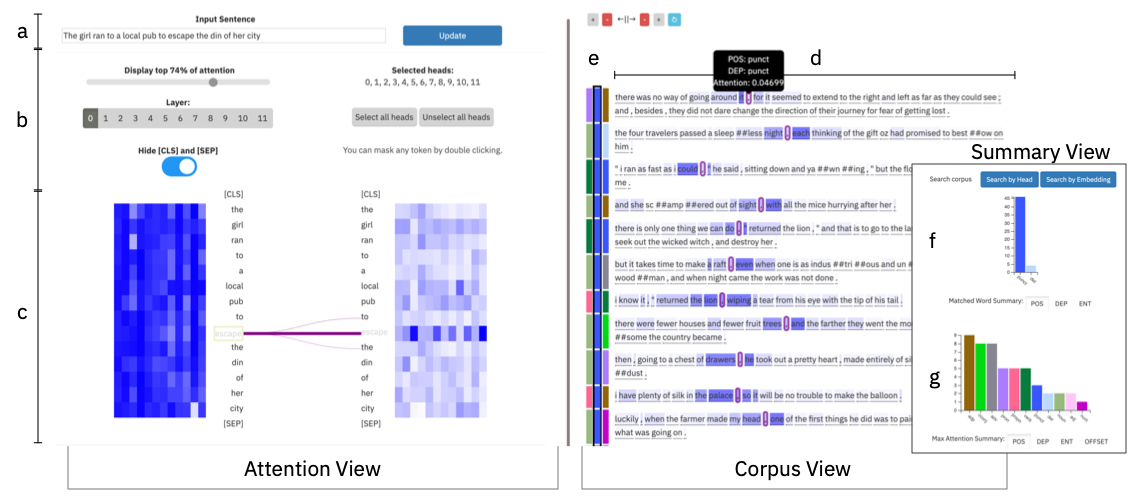by Ben Hoover, Hendrik Strobelt, Sebastian Gehrmann
from IBM Research and Harvard NLP
Link to pre-paper and demo: exbert.net

exBERT is a tool that enables users to explore the learned attention weights and contextual representations of different huggingface Transformer models. Input a sentence, and exBERT will pass the tokenized input through the specified model, visualizing attentions as curved lines and allowing the embeddings to be searchable across an annotated corpus, if available.
Features:
- Support for many of the common Transformer models (e.g., BERT, GPT2, DistilBERT, DistilGPT2, Roberta, ALBERT, )
- Toggle visibility of the attentions to the
[CLS]and[SEP]tokens that often assume the functionality of ano-operationof a particular head. - For masked language models, interactively mask particular tokens and observe how this affects the attention patterns
- Observe what a model would predict at (bidirectional models) or following (autoregressive models) a particular token
- View the attention patterns of single heads or any linear combination of heads
- Search for the contextual representation of any token at the output of any layer across a corpus annotated by that model
- Discover linguistic features (e.g., Part of Speech, Dependencies, Entities) learned by particular heads.
Limitations:
- exBERT does not visualize the attention between pairs of input sequences. All inputs are assumed to come from a single sequence.
- Has only been developed to support English
Support for visualizing the attentions only is available out of the box. This minimal visualization is available with select deployed models on Huggingface's model page here.
Significant preprocessing needs to be performed to allow corpus searching. Please see the instructions here
Simply run make env from the root directory
- From the root of this project, create a new conda directory with
conda env create -f environment.yml. This will create an environment namedexbert. - (optional) Intstall development dependencies with
conda env update -f environment-dev.yml - Activate this environment with
conda activate exbert pip install -e server/transformerspip install -e server/spacyfacepip install -e server- Install English support for spaCy
python -m spacy download en_core_web_sm
Out of the box configuration is the same as the demo at [www.exbert.net].
conda activate exbert
python server/main.pyLimitations:
- The model architecture must be supported by the
AutoModelWithLMHead - Corpus searching support is only available for English
- Searching by context requires tweaking of the actual architecture code to extract this information. If your architecture has not been modified to support this extraction, it will not run.
- Save your pretrained huggingface model according to the naming conventions specified in the
modeling_auto.pyof the original Transformers repo (as of v2.8):
The model class to instantiate is selected as the first pattern matching
in the `pretrained_model_name_or_path` string (in the following order):
- contains `t5`: T5Model (T5 model)
- contains `distilbert`: DistilBertModel (DistilBERT model)
- contains `albert`: AlbertModel (ALBERT model)
- contains `camembert`: CamembertModel (CamemBERT model)
- contains `xlm-roberta`: XLMRobertaModel (XLM-RoBERTa model)
- contains `roberta`: RobertaModel (RoBERTa model)
- contains `bert`: BertModel (Bert model)
- contains `openai-gpt`: OpenAIGPTModel (OpenAI GPT model)
- contains `gpt2`: GPT2Model (OpenAI GPT-2 model)
- contains `transfo-xl`: TransfoXLModel (Transformer-XL model)
- contains `xlnet`: XLNetModel (XLNet model)
- contains `xlm`: XLMModel (XLM model)
- contains `ctrl`: CTRLModel (Salesforce CTRL model)
-
Create the reference corpus. Instructions here. Warning: Depending on the number of layers and size of the hidden dimension in the model, this step could take many gigabytes on your computer to store the hidden representations and attentions at every layer.
-
Run
python server/main.py --model PATH_TO_MODEL --kind {bidirectional | autoregressive} --corpus PATH_TO_CORPUS, selecting bidirectional if your model was trained with masking (e.g., BERT) and autoregressive otherwise (e.g., GPT2).PATH_TO_CORPUSshould be the name of the directory containingdata.hdf5,embedding_faiss/andcontext_faiss.
Because exBERT lazy-loads the large annotated corpus and models, the first call to search across the corpus will be slow.
cd client/src
npm install #installs all necessary node packages
npm run build #This will create the static files living in `client/dist`. You can run a client server that automatically recompiles the frontend with npm run watch rather than npm run build. After making a change, you should be able to refresh the browser window to see your most recent changes.
Because the backend has to load in a lot of data for inference, we do not allow auto-backend refresh on every saved change.
This project was inspired in part by the original BertViz by Jesse Vig.
This project makes use of two public pip repositories (transformers and spacyface), both of which needed modification as this project was being developed. The git-subrepo tool was used to achieve this workflow with a forked repository of both transformers and spacyface. However, this introduces the following steps when setting up the environment:
- From the
transformers/directory, runpip install -e . - Repeat for the
spacyface/directory.
- If you get a
No module named '_swigfaiss'error, check thatlibompis installed on your system. If you are on a mac, this is as simple asbrew install libomp.
